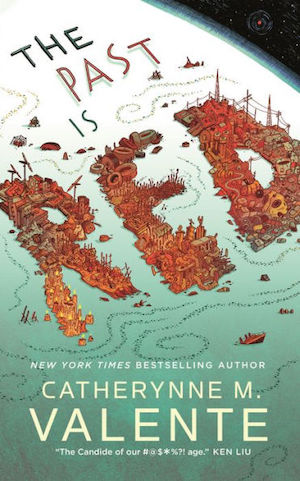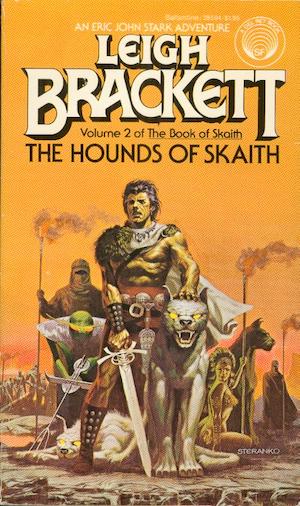In this bi-weekly series reviewing classic science fiction and fantasy books, Alan Brown looks at the front lines and frontiers of the field; books about soldiers and spacers, scientists and engineers, explorers and adventurers. Stories full of what Shakespeare used to refer to as “alarums and excursions”: battles, chases, clashes, and the stuff of excitement.
Today I’ll be looking at the second volume of Leigh Brackett’s Skaith series, The Hounds of Skaith. The middle of a trilogy is a tough spot for books, as they tend to lack the freshness and energy of a first volume and the satisfying finality of a third volume. If second books were athletes, they’d be the unsung player who sets up the hero who scores to win the game. In this case, however, thanks to the headlong energy of Brackett’s barbarian hero Eric John Stark, the introduction of some fierce animal sidekicks, and a steady unfolding of new insights into the mysterious planet Skaith, this book moves along at a good clip, keeping the reader engaged throughout.
This is only the second time in this review series that I have covered a sequel. One of the things I try to do is to introduce old classics to a new generation, which usually means I am discussing a standalone book or the first book in a series. My first brush with sequels was when I reviewed the entire Lensman series, because I wanted to give due consideration to one of the pioneers of the field, E. E. “Doc” Smith. And armed with a stack of books that I was lucky to stumble upon at my local used bookstore, I have recently been trying to do the same thing with another pioneer, Leigh Brackett, working though her many short stories and her few full-length novels.
In Our Last Installment…
I avoided spoiling the ending in my review of The Ginger Star, but cannot discuss the sequel without revealing the events of that first volume. And, in fact, it is probably best that I briefly recap the entire story to date. The red sun of the planet Skaith is dying, and the planet is fading along with it. The spacefaring Galactic Union discovered the planet, and their desire for open trade and the possibility of emigration upset the powers that be—chiefly the Lords Protector who have ruled as despots from their northern Citadel for generations, their will enforced by the cruel Wandsmen. They captured Galactic Union official Simon Ashton, and his adopted son Eric John Stark arrived on the planet to rescue him. Stark was a human foundling raised by a primitive tribe; when the tribe was destroyed, Ashton adopted Stark, who never lost the fierce savagery of his upbringing, and who has traveled the stars as a mercenary.
Fighting the Wandsmen and the indigent Farers they support, Stark made his way to Irnan, a city revolting against the Wandsmen. There, the prophetess Gerrith predicted that Stark would bring down the Citadel and end the rule of the Lords Protector. And, fighting his way through the ferocious tribes and mysterious races of Skaith, Stark does exactly that. At the Citadel, facing the fierce northhounds that guard it, Stark’s fierce nature allows him to overcome their telepathic ability to project fear into their prey’s minds, kill their leader, and become master of the pack. Despite Ashton being rescued and most of the plot threads being resolved, however, the tale ends with Gerrith, who has become Stark’s lover, captured by Chief Wandsman Gelmar, and Stark setting out to free her.
About the Author
Leigh Brackett (1915-1978) was a noted science fiction writer and screenwriter, perhaps best-known today for one of her last works, the first draft of the script for Star Wars: The Empire Strikes Back. I’ve reviewed Brackett’s work before—the omnibus edition Eric John Stark: Outlaw of Mars, the novel The Sword of Rhiannon, the novelette “Lorelei of the Red Mist” in the collection Three Times Infinity, the short story “Citadel of Lost Ships” in the collection, Swords Against Tomorrow, the collection The Best of Leigh Brackett, and the first book of the Skaith Trilogy, The Ginger Star.
That last review also contains information on the demise of planetary romance stories set in our solar system, and on this first interstellar setting for an Eric John Stark tale. In each of those reviews, you will find more information on Leigh Brackett and her career. Like many authors whose careers started in the early 20th century, you can find a number of Brackett’s stories and novels on Project Gutenberg.
Animal Companions
While the middle volumes of trilogies often lose a bit of momentum, there is nothing like introducing a good animal companion to a story to help pique the readers’ interest! Animal companions are a common feature in science fiction and fantasy, although surprisingly I couldn’t find that discussed as a theme in the usually comprehensive online Encyclopedia of Science Fiction. That’s surprising, as you can’t swing a dead cat in the genre without hitting some sort of pet, working animal, or companion creature, usually with some sort of empathic or telepathic link with its human (perhaps that ‘dead cat’ phrase, which refers to a cat-o-nine-tails, and not an actual cat, was not the best fit for this situation, but there it is). With all the cherished pets in the world, it is no surprise writers and readers would enjoy projecting their bonds with those animals into the world of speculative fiction.
Buy the Book


The Past Is Red
Going back through my past reviews, I found I’ve touched upon a whole slew of books that showcase animal companions. Andre Norton’s Beast Master has a menagerie of creatures that assist the protagonist, and many of her other works also feature animal sidekicks. David Weber’s Honor Harrington has her treecat, Nimitz. I suspect Murray Leinster was a pet owner, because his famous tale “Exploration Team” centers on an explorer with bear and eagle companions, and his Med Ship tales gave us the helpful chimpanzee-like “tormal”/traveling test subject, Murgatroyd. Sharon Lee and Steve Miller’s Liaden series, which began with Agent of Change, is full of seemingly-sentient trees and uncannily clever cats (and the authors are cat owners themselves). In Heinlein’s Starship Troopers, there are K-9 teams with enhanced bonds between soldier and working dog. H. Beam Piper’s Little Fuzzy introduces us to clever little creatures that turn out in the long run to be more than just pets. James H. Schmitz’s character Telzey Amberdon develops telepathic bonds with a whole host of diverse creatures. And I wouldn’t be surprised if I overlooked a few creatures in this summary.
There have been a number of articles on Tor.com over the years that talk about animal sidekicks, including this one last published in 2018 from Laura Bickle; this list of people who communicate with animals from 2020; and this ongoing series from Judith Tarr that looks at horses in fact and fiction.
The Hounds of Skaith
The book opens with the Children-of-Skaith-our-Mother, the genetically altered branch of humanity that lurks in underground caves, plotting to kill Stark. At the same time, Stark and Ashton are pursuing the Wandmen that have absconded with Stark’s lover, the seer Gerrith. The relationship between the northhounds of Skaith and Stark is an intriguing one. They are a perfect mirror for the savage persona, N’Chaka, that lurks beneath his civilized exterior, and are valuable allies in the savage wilds of Skaith. But Stark also has a tiger by the tail, because they follow the strongest member of the pack, and if he ever shows weakness, their way is to kill him—just like he killed the previous pack leader.
The third chapter is a very dense summary of everything that occurred in the last volume, almost pure exposition. They encounter the defeated Lords Protector, fleeing south after Stark destroyed their Citadel. The northhounds’ bond to Stark is tested by their old masters, but they remain loyal to their new pack leader. Then they encounter the Wandsmen, and their archenemy, Chief Wandsman Gelmar. A storm forces everyone to shelter together in a tense standoff. Stark leaves, taking Gerrith and his companions with him. The tribesmen allies of the Wandsmen send a flying creature to call the tribes to war. After various twists and turns, Stark is given the blessing of the Fallarin, another genetically altered race of humans. They have large wings, but in a nod to science, cannot fly, but only glide for short distances. They also have an unexplained ability to control the winds, which is a fierce weapon.
The Fallarin’s support wins over most of the tribesmen to Stark’s side of the conflict, although there is a fierce battle against a tribe that holds out. Stark decides the best course of action is to take the Wandsman base of Yurunna—the promise of loot will keep his tribal allies together, and while Stark has Gerrith and Ashton back, it is increasingly clear that if he ever wants to get off the planet, he will have to take down the entire power structure of the Wandsmen. Yurunna is also the place where the northhounds are bred, which generates another challenge to Stark’s control of his pack. The Lords Protector did not realize it, but when they kidnapped Ashton, they unleashed a one-man force that would irrevocably change their world. The only drawback of this development is that it turns Stark into a general, which is not as enjoyable as when he is operating as a lone warrior. Toward the end of the book, however, he embarks on a lone mission which puts him in his natural element again.
This trilogy is Brackett’s only multi-volume tale that I know of. She was reputed to be a “seat of the pants” writer who plotted as she went, and these books certainly have that feel. While there is plenty of action to keep the reader turning pages, at times I felt that the overall story arc was a bit weak. As Stark wandered, so did the narrative, from event to event, and from strange opponent to strange opponent. Skaith is an interesting setting, but occasional foreshadowing of future encounters would have kept some of the new challenges from feeling like they came out of nowhere. That being said, the battle scenes (as is always the case with Brackett) were exciting and evocative. And the ending was like that of the first volume, a conclusive event that kept only a few plot threads in motion to lead in to the next volume. I wish more authors would emulate that approach instead of relying on the cliffhanger endings so common these days, especially in middle volumes of trilogies.
Final Thoughts
The Hounds of Skaith is a perfectly decent middle volume for a trilogy, introducing some new elements to the story and setting up the pieces for the grand finale in the final volume. It also adds some spice to the narrative with animal companions for Stark, the eponymous hounds, that perfectly fit his own fierce personality.
Leigh Brackett would go on from this work to write the first draft of the script for The Empire Strikes Back, one of the most successful second parts of a trilogy ever filmed. I’ll turn over the floor here for comments on this book. I’d also be interested in hearing about your own favorite animal companions from speculative fiction, along with your thoughts on trilogies and their middle volumes—both those that worked, and those that didn’t.
Alan Brown has been a science fiction fan for over five decades, especially fiction that deals with science, military matters, exploration and adventure.










